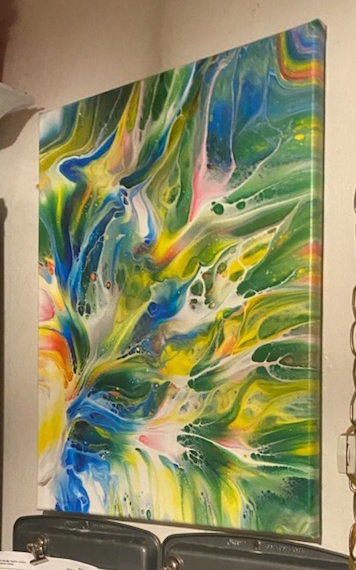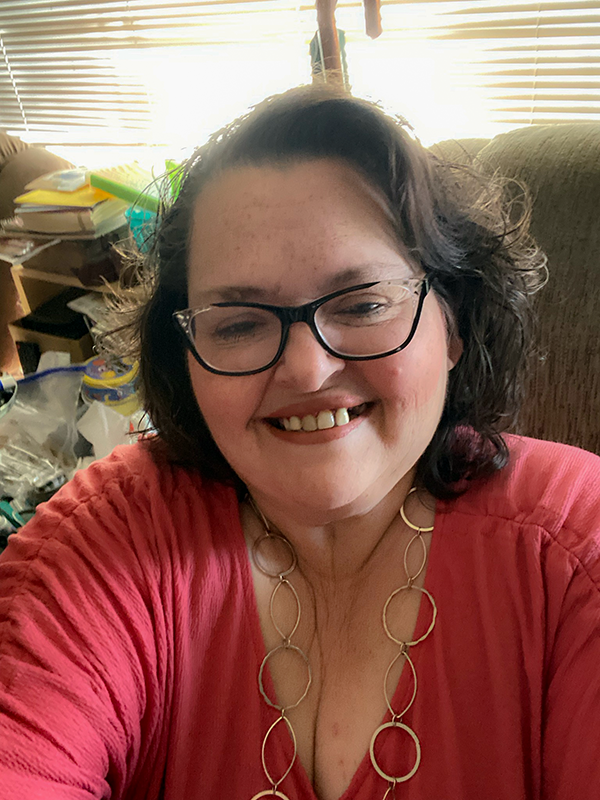Michelle McKay is One Stubborn Survivor
The first thing you need to know about Michelle McKay is that she’s stubborn.
She’s working on it, but truth be told, it’s what defines her. “I used to be a perfectionist, mostly because I wanted things done the right way,” she confesses. Ironically, this drive is what kept her going when everything went sideways.
At 54, Michelle is on a mission. She wants other stroke survivors to know that though recovery can be hard, “It can lead to a better you. There’s no end to what we’re capable of,” is her motto.
Michelle McKay is One Stubborn Survivor
The first thing you need to know about Michelle McKay is that she’s stubborn.
She’s working on it, but truth be told, it’s what defines her. “I used to be a perfectionist, mostly because I wanted things done the right way,” she confesses. Ironically, this drive is what kept her going when everything went sideways.
At 54, Michelle is on a mission. She wants other stroke survivors to know that though recovery can be hard, “It can lead to a better you. There’s no end to what we’re capable of,” is her motto.
Born in Michigan, Michelle was constantly sick, regularly getting pneumonia. When she was four, she and her parents moved to the warmer climate of Phoenix to improve her health.
Fast forward to February 2017. Michelle was at work as an administrative assistant making a photocopy. It was the end of day and she suddenly felt dizzy, so she went home. She called a friend who suggested she was probably tired and should just rest.
The next morning at work, a co-worker commented that she wasn’t looking right. “I called a friend who told me to call 911. I said that wasn’t necessary, but my friend threatened to call if I didn’t,” Michelle recalls. Her husband BJ brought her to the ER at St. Joe’s, where an MRI revealed she’d had a small stroke.
“I figured, great, it’s a small one. Can I go home now?” she remembers.
Michelle was admitted to the hospital, and while there, she had another stroke. Despite some issues with her body’s regulation of her blood sugar and blood pressure, as well as difficulty walking, she wanted to go home so she could return to work within two days… which she did. That Monday, after falling asleep at her desk, she realized something was off and she needed help.
In short order, she began going to Vocational Rehabilitation and started a new job at a Phoenix resale store run by the Brain Injury Alliance of Arizona that employed brain injury survivors. After the store closed due to COVID-19 safety measures, Michelle was immediately hired by a large company and started working from home.
In 2020, history would repeat itself. One morning, she had trouble waking up out of a heavy sleep. Michelle says, “My alarm clock saved my life.” She knew something was wrong because the room wouldn’t stop spinning, so she called BJ, who in turn called their daughter and his mom. Paramedics arrived in minutes.
Six months into her new job, she woke up and again the room was spinning. Her speech was slurred, she felt nauseous, and couldn’t stand or walk. She didn’t realize it at the time, but this was her third stroke — this time a massive one.
The next thing she knew, paramedics were putting her onto a gurney and whisking her to the hospital. During the next seven weeks, she was in the ICU twice as doctors drilled a hole in her head; first to relieve pressure, then to fight an infection in her brain. They also informed her that she would need to be in an after-care facility, but her family wanted her to come home. This situation was compounded by the fact that the COVID pandemic was raging, and no visitors were allowed in the hospital.
“Like many others, I was cut off from family and friends for weeks when I needed them most,” she recalls. “I remember I wanted to give my wallet to my daughter who was in the lobby. There I was in a wheelchair, and they wouldn’t even let me give it to her. It was awful.”
As loneliness and struggles to regain many basic functions intensified, she couldn’t wait to get home. Even though she credits her medical team for their professionalism, there was no substitute for family. But things didn’t go exactly as planned.
“When I got home, my family didn’t recognize me. I just wasn’t who I used to be,” Michelle shares. She likens her experience to shaking a snow globe. “When it stops, you see where everything settles. That’s why I say the stroke happens to the whole family.”
Previously, Michelle had always done things her way. “I was a real control freak,” she readily admits. Now, reality had settled in and she realized she couldn’t do everything herself. The challenge was coming to terms with not being perfect and developing more realistic expectations of herself and her family.
This also meant changing the dynamic with her daughter (now 21) and her husband of 22 years. “I used to do everything for them, but that had to change for me and them,” she says.
She was amazed how her daughter had taken over managing the household, including making dinner for the family as well as cleaning. Her husband also helped her with her basic needs. “I couldn’t shower alone until four weeks ago. My balance is terrible and it’s hard to stand since there’s not a great connection between my brain and body,” she tells. “It’s very frustrating and I know I get cranky.”
Michelle also feels guilty about being in this position. “I was angry at myself that I missed having my kid’s Sweet 16 after my first two strokes. I was like, ‘how dare you?!’ But now, learning my limits and setting boundaries has actually made me a better mother and wife.” She is particularly proud of her daughter’s recent graduation from Grand Canyon University.
As Michelle continues to recover from her third stroke, she is outspoken about people who think there’s a quick fix. “Doctors say I should lose weight and be healthier. It’s not that simple,” she points out. “Nobody ever says they intentionally want to be fat and have a stroke.”
Brittany Sweeney-Lawson, Director of Care Coordination for the Brain Injury Alliance, concurs. “We make a lot of assumptions about a person based on their appearance, and when we judge a book by it’s cover, we miss a lot of important parts of the story,” she says. “Truth be told, you can’t necessarily tell how healthy someone is by looking at them, anymore than you can determine if they have a disability.” We need to do a better job as a society about believing people when they tell us about their health needs and concerns, or they will stop trusting us to help them.”
While Michelle sometimes still struggles with her desire for perfection, one aspect of her pursuit of it has been a saving grace for her. Simply put, she can make a craft out of anything. “I can walk down the aisle of an art store, see scraps of fabric, some paper, beads, wire, and a jar, then automatically imagine them together in my head, and make an amazing craft.”
 This penchant for abstract art has led her to the Brain Injury Alliance-sponsored Art of Healing – Acrylic Pour Class to feed her need to create. Her latest piece is on her inspiration wall at home to remind her of how far she has come.
This penchant for abstract art has led her to the Brain Injury Alliance-sponsored Art of Healing – Acrylic Pour Class to feed her need to create. Her latest piece is on her inspiration wall at home to remind her of how far she has come.
Laura Johnson, Survivor Engagement Coordinator of the Brain Injury Alliance, says Michelle is incredible. “I’m truly inspired by her involvement and enthusiasm. I’ve seen her hiccups and her triumphs. Believe me, this is one impressive lady.”
At 54, Michelle is on a mission. She wants other stroke survivors to know that though recovery can be hard, “It can lead to a better you. There’s no end to what we’re capable of,” is her motto.
As someone who has been active with the Brain Injury Alliance of Arizona for years, availing herself of their free programs and services like regular support groups and social activities, Michelle believes in walking the talk by giving back. She currently helps other survivors by volunteering at various Brain Injury Alliance events and tells her story to help others deal with their new reality. “We’re all in this together and I want people to know that their life isn’t over, it’s just different,” she reminds.
“No matter what the challenge, you need to lead your best life to survive and thrive.”
By any measure, her stubbornness is paying off.
ABOUT BRAIN INJURY ALLIANCE OF ARIZONA
The Brain Injury Alliance of Arizona (BIAAZ) is the only statewide nonprofit organization dedicated to improving the lives of adults and children with all types of brain injuries through prevention, advocacy, awareness and education. BIAAZ also houses the Arizona Brain Health Resource Center, a collection of educational information and neuro-specific resources for brain injury survivors, caregivers, family members and professionals.
What began in 1983 as a grassroots effort has grown into a strong statewide presence, providing valuable life-long resources and community support for individuals with all types of brain trauma at no charge.
The Brain Injury Alliance of Arizona:
- Works with Congressional Brain Injury Task Force
- Houses Arizona Brain Health Resource Center
- Hosts Statewide Opioid Use Disorder & Cognitive Impairment Workgroup
- Has Statewide Opioid Use Disorder & Cognitive Impairment Response team with peer support, training, and family wraparound services
- Facilitates Brain Health Advisory Council
- Manages statewide Neuro Info-Line: 888-500-9165






